"Jange-e-Azadi"
(War of Independence)
 Although the British Empire expanded, the native Indians never
accepted their dominance. On May 10, 1857, Indian soldiers of the British Indian Army, drawn mostly from Muslim units from Bengal, rose against the British in the Meerut garrison some 80 km from Delhi and marched to Delhi.
The rising was mainly to protest against the use of the newly issued rifle
bullets, alleged to have a wax sealing made of the fats of pigs that was to
be removed from the teeth before use. Since pigs are forbidden in the Islam,
the Muslim soldiers resented its use and took up arms against their British
masters. At Delhi, they captured the famous "Lal Qila" (Red Fort) and reinstated Bahadar Shah Zafar (the last Mughul monarch) to throne. Soldiers in
other garrisons also followed the suit and soon much of north and central India was plunged into a year-long insurrection against the British. The British reacted and laid a siege of the Fort, which continued for a while but finally the British owing to their access to artillery and large number of forces stormed the Fort. Bahadur Shah Zafar fled to Humayun's tomb. The British plundered Delhi and killed many Indian soldiers (and civilians) and artillery was set up in the main mosque in the city to bombard suspected localities, specially the homes of the Muslim nobility. The British forces also arrested Bahadur Shah and days after the arrest, a British officer William Hodson shot Shah's sons Mirza Moghul, Mirza Khizr Sultan, and Mirza Abu Bakr and shamefully presented their heads to the Shah. Although the British Empire expanded, the native Indians never
accepted their dominance. On May 10, 1857, Indian soldiers of the British Indian Army, drawn mostly from Muslim units from Bengal, rose against the British in the Meerut garrison some 80 km from Delhi and marched to Delhi.
The rising was mainly to protest against the use of the newly issued rifle
bullets, alleged to have a wax sealing made of the fats of pigs that was to
be removed from the teeth before use. Since pigs are forbidden in the Islam,
the Muslim soldiers resented its use and took up arms against their British
masters. At Delhi, they captured the famous "Lal Qila" (Red Fort) and reinstated Bahadar Shah Zafar (the last Mughul monarch) to throne. Soldiers in
other garrisons also followed the suit and soon much of north and central India was plunged into a year-long insurrection against the British. The British reacted and laid a siege of the Fort, which continued for a while but finally the British owing to their access to artillery and large number of forces stormed the Fort. Bahadur Shah Zafar fled to Humayun's tomb. The British plundered Delhi and killed many Indian soldiers (and civilians) and artillery was set up in the main mosque in the city to bombard suspected localities, specially the homes of the Muslim nobility. The British forces also arrested Bahadur Shah and days after the arrest, a British officer William Hodson shot Shah's sons Mirza Moghul, Mirza Khizr Sultan, and Mirza Abu Bakr and shamefully presented their heads to the Shah.
|
Ali Garh to Muslim League
As a consequence to 1857 events, the British government brought India under the direct control of Crown and a Viceroy was appointed to represent the Crown. They also increased the number of British soldiers in relation to native and allowed only British soldiers to handle artillery. In 1877 Queen Victoria took the title of Empress of India. Bahadur Shah was exiled to Rangoon, in Burma where he died in 1862, finally bringing the Mughal dynasty to an end. Although the "Jange-e-Azadi" (Liberation War) was brutally quelched, the spark for independence and throwing away the yoke of slavery at the hands of the
British had been ignited.
While the War of Independence had many repercussions, the intolerance towards the Muslims by the British
increased manifold and the Muslims felt deprived and left out in fields of education and representation in government service. Attacks by Hindu fundamentalists against religious conversion, cow killing, and the preservation of Urdu in Arabic script deepened their fears of minority status.
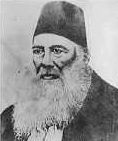 In order to keep the Muslims in the mainstream, rose Sir Syed Ahmad Khan and launched a movement for Muslim regeneration that culminated in the founding of the Muhammadan Anglo-Oriental College at Aligarh in 1875 (later renamed Aligarh Muslim University in 1921). Its objective was to educate Muslims by emphasizing the compatibility of Islam with western knowledge. In order to keep the Muslims in the mainstream, rose Sir Syed Ahmad Khan and launched a movement for Muslim regeneration that culminated in the founding of the Muhammadan Anglo-Oriental College at Aligarh in 1875 (later renamed Aligarh Muslim University in 1921). Its objective was to educate Muslims by emphasizing the compatibility of Islam with western knowledge.
On 30 December 1906 the All-India Muslim League was founded to safeguard the interests of the Muslims. A delegation also met with the viceroy, Gilbert John Elliot, seeking special considerations in government service and electorates. This had positive effect and in 1911 When King-Emperor George V visited India, he announced the reversal of the partition of Bengal and the transfer of the capital from Calcutta to
present day New Delhi.
|
Jinnah and Pakistan Movement
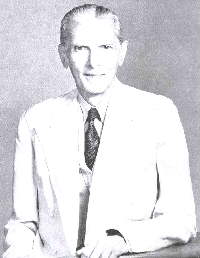 Muhammad Ali Jinnah, who had initially joined the Congress was grossly dissatisfied with the Congress attitude towards Muslims and thus joined the Muslim League in 1913. It was with his efforts that Congress
recognized the separate position of the Muslims and the Muslims' demand for a separate electorate as a part of the Lucknow Pact. However the Hindu prejudice against the Muslims could not be hidden for long and the publication of Nehru Report (1928) was a great setback to Lucknow Pact, since the Nehru Report negated all its clauses. It became evident that Congress and Hindus wanted to become the ruler of India on the basis of numerical strength and make Muslims their subjects. This was not acceptable to Muslims since they had ruled India for centuries and after British
subjugation, they were again to fall under the Hindus as their subjects. Jinnah therefore refused to accept the report and presented his famous 14 Points to solve the political problems in India. Muhammad Ali Jinnah, who had initially joined the Congress was grossly dissatisfied with the Congress attitude towards Muslims and thus joined the Muslim League in 1913. It was with his efforts that Congress
recognized the separate position of the Muslims and the Muslims' demand for a separate electorate as a part of the Lucknow Pact. However the Hindu prejudice against the Muslims could not be hidden for long and the publication of Nehru Report (1928) was a great setback to Lucknow Pact, since the Nehru Report negated all its clauses. It became evident that Congress and Hindus wanted to become the ruler of India on the basis of numerical strength and make Muslims their subjects. This was not acceptable to Muslims since they had ruled India for centuries and after British
subjugation, they were again to fall under the Hindus as their subjects. Jinnah therefore refused to accept the report and presented his famous 14 Points to solve the political problems in India.
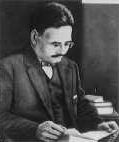 The Muslims wished that their separate identity should be
recognized and provided constitutional safeguards to protect their rights. It was then that the first proponents of independent Muslim nation began to appear. Among the first of these was writer/philosopher Allama Iqbal, who felt that a separate nation for Muslims was essential in an otherwise Hindu-dominated subcontinent. The cause found a leader in Muhammad Ali Jinnah, who became known as Father of the Nation and eventually persuaded the British to partition the region into Muslim-majority Pakistan, and Hindu-majority India. The Muslims wished that their separate identity should be
recognized and provided constitutional safeguards to protect their rights. It was then that the first proponents of independent Muslim nation began to appear. Among the first of these was writer/philosopher Allama Iqbal, who felt that a separate nation for Muslims was essential in an otherwise Hindu-dominated subcontinent. The cause found a leader in Muhammad Ali Jinnah, who became known as Father of the Nation and eventually persuaded the British to partition the region into Muslim-majority Pakistan, and Hindu-majority India.
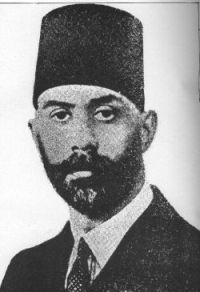 In the meantime Choudhary Rahmat Ali a ambridge student coined the word "PAKISTAN" for a would-be Muslim country, which was published on 28th January 1933 in the pamphlet "Now or Never." He made the name an acronym of the different states/homelands/regions, which broke down into: In the meantime Choudhary Rahmat Ali a ambridge student coined the word "PAKISTAN" for a would-be Muslim country, which was published on 28th January 1933 in the pamphlet "Now or Never." He made the name an acronym of the different states/homelands/regions, which broke down into:
P(Punjab), A(Afghania - a reference to the North West Frontier Province), K(Kashmir), S(Sindh) and TAN(BalochisTAN), thus forming "'PAK - STAN'".
An "i"' was later added to the the name to ease pronunciation, producing "PAKISTAN."
|
The Lahore Resolution
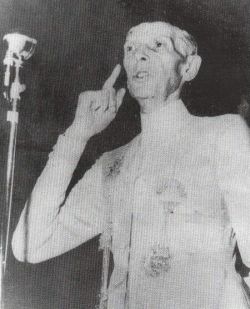 The British Government under the new constitution held the elections in 1937, in which Congress gained majority and formed government in six large provinces. In
connivance with the government, Hindus started persecuting the Muslims and Hindi was introduced instead of Urdu. The introduction of "Bande Matram", the Hindus' national anthem did the rest. Therefore, the Muslim League decided to ask for a separate homeland for
themselves as by now it was clear that both Hindus and Muslims could not co-exist under one flag. In the 27th annual session on 23 March 1940 at Lahore, the Muslim League under
Jinnah demanded a separate homeland for the Muslims of Indian sub-continent. Thereafter, Muslims all over India were asked to join Muslims League to safe guard their identity. In the meantime the 2nd world War had already started and the British government wanted whole hearted Indian support, therefore the Viceroy promised that the constitution would be framed in consultation
with representatives of the people after the war.
The British Government under the new constitution held the elections in 1937, in which Congress gained majority and formed government in six large provinces. In
connivance with the government, Hindus started persecuting the Muslims and Hindi was introduced instead of Urdu. The introduction of "Bande Matram", the Hindus' national anthem did the rest. Therefore, the Muslim League decided to ask for a separate homeland for
themselves as by now it was clear that both Hindus and Muslims could not co-exist under one flag. In the 27th annual session on 23 March 1940 at Lahore, the Muslim League under
Jinnah demanded a separate homeland for the Muslims of Indian sub-continent. Thereafter, Muslims all over India were asked to join Muslims League to safe guard their identity. In the meantime the 2nd world War had already started and the British government wanted whole hearted Indian support, therefore the Viceroy promised that the constitution would be framed in consultation
with representatives of the people after the war.
In 1942 Sir Stafford Cripps proposed dominion status to India under British Crown.
While Congress rejected the proposal since it wanted full control over the affairs of the government, Muslim League rejected it since it
didn't promise a separate homeland for them. Thereafter between 1942-45 many attempts were made to break the deadlock, but the Congress refused to accept the separate identity for the Muslims. This further united the Muslims, which resulted into land slide victory for Muslims in 1945-46 elections. It clearly showed that Muslims were a separate entity and that their demand for a separate homeland was just.
|
The Final Days
The one year period between 1946 till partition of India was very confusing, disturbing and crucial for the future of the Muslims. The British now
realized that Muslims were a powerful entity and could not be ignored. But at the same time they never wanted to annoy the Hindus who were in majority. Therefore in 1946, a
delegation from England arrived with three suggestions: (1) The Constituent Assembly should prepare the constitution, (2) Adoption of federal form of government and (3) British India to be divided in three groups: (a) First Group - Muslim majority provinces of Bengal and Asam, (b) Second Group - Punjab, NWFP, Sind and Balochistan and (c) the Hindu majority Third Group.
All groups should
compulsorily remain in the Federation for TEN YEARS, after which they had the choice to get separated and become independent.
Congress obviously rejected the proposal since it saw creation of Pakistan after ten years while Muslims rejected it since they could not wait for ten years. Therefore Muslim League started a country wide campaign to expose the covert collaboration between the Congress and the government. After the failure of a provisional
government in 1946, where Congress and League members could not sit together, on 20 February 1947 the British Prime Minister Lord
Attlee declared that British government would transfer power to people of subcontinent by June 1948. However the new Viceroy Lord Mountbatten assessed that there was no hope for a
political reconciliation and only solution was division of British India into two independent states; Bharat
(India) for Hindus and Pakistan for Muslims. On June3, 1947, the partition of British India and establishment of Pakistan on 14th August 1947 was announced.
|
End of an Empire
 With
the creation of Pakistan on 14 August 1947,
the British Indian Empire faded into
the history. But left behind
many a scars that still haunt peace and stability in the region. Kashmir
being the major dispute because of which not only peace in the region is
unattainable but has brought India and Pakistan face to face on a number of
occasions. The latest escalation in year 2002 almost brought the two nations
at brink of war and at a nuclear flash point. So long the dispute remains
unresolved, no worthwhile peace can be ensured in the region and people of
both countries would continue to suffer. With
the creation of Pakistan on 14 August 1947,
the British Indian Empire faded into
the history. But left behind
many a scars that still haunt peace and stability in the region. Kashmir
being the major dispute because of which not only peace in the region is
unattainable but has brought India and Pakistan face to face on a number of
occasions. The latest escalation in year 2002 almost brought the two nations
at brink of war and at a nuclear flash point. So long the dispute remains
unresolved, no worthwhile peace can be ensured in the region and people of
both countries would continue to suffer.
|
 Although the British Empire expanded, the native Indians never
accepted their dominance. On May 10, 1857, Indian soldiers of the British Indian Army, drawn mostly from Muslim units from Bengal, rose against the British in the Meerut garrison some 80 km from Delhi and marched to Delhi.
The rising was mainly to protest against the use of the newly issued rifle
bullets, alleged to have a wax sealing made of the fats of pigs that was to
be removed from the teeth before use. Since pigs are forbidden in the Islam,
the Muslim soldiers resented its use and took up arms against their British
masters. At Delhi, they captured the famous "Lal Qila" (Red Fort) and reinstated Bahadar Shah Zafar (the last Mughul monarch) to throne. Soldiers in
other garrisons also followed the suit and soon much of north and central India was plunged into a year-long insurrection against the British. The British reacted and laid a siege of the Fort, which continued for a while but finally the British owing to their access to artillery and large number of forces stormed the Fort. Bahadur Shah Zafar fled to Humayun's tomb. The British plundered Delhi and killed many Indian soldiers (and civilians) and artillery was set up in the main mosque in the city to bombard suspected localities, specially the homes of the Muslim nobility. The British forces also arrested Bahadur Shah and days after the arrest, a British officer William Hodson shot Shah's sons Mirza Moghul, Mirza Khizr Sultan, and Mirza Abu Bakr and shamefully presented their heads to the Shah.
Although the British Empire expanded, the native Indians never
accepted their dominance. On May 10, 1857, Indian soldiers of the British Indian Army, drawn mostly from Muslim units from Bengal, rose against the British in the Meerut garrison some 80 km from Delhi and marched to Delhi.
The rising was mainly to protest against the use of the newly issued rifle
bullets, alleged to have a wax sealing made of the fats of pigs that was to
be removed from the teeth before use. Since pigs are forbidden in the Islam,
the Muslim soldiers resented its use and took up arms against their British
masters. At Delhi, they captured the famous "Lal Qila" (Red Fort) and reinstated Bahadar Shah Zafar (the last Mughul monarch) to throne. Soldiers in
other garrisons also followed the suit and soon much of north and central India was plunged into a year-long insurrection against the British. The British reacted and laid a siege of the Fort, which continued for a while but finally the British owing to their access to artillery and large number of forces stormed the Fort. Bahadur Shah Zafar fled to Humayun's tomb. The British plundered Delhi and killed many Indian soldiers (and civilians) and artillery was set up in the main mosque in the city to bombard suspected localities, specially the homes of the Muslim nobility. The British forces also arrested Bahadur Shah and days after the arrest, a British officer William Hodson shot Shah's sons Mirza Moghul, Mirza Khizr Sultan, and Mirza Abu Bakr and shamefully presented their heads to the Shah.
 In order to keep the Muslims in the mainstream, rose Sir Syed Ahmad Khan and launched a movement for Muslim regeneration that culminated in the founding of the Muhammadan Anglo-Oriental College at Aligarh in 1875 (later renamed Aligarh Muslim University in 1921). Its objective was to educate Muslims by emphasizing the compatibility of Islam with western knowledge.
In order to keep the Muslims in the mainstream, rose Sir Syed Ahmad Khan and launched a movement for Muslim regeneration that culminated in the founding of the Muhammadan Anglo-Oriental College at Aligarh in 1875 (later renamed Aligarh Muslim University in 1921). Its objective was to educate Muslims by emphasizing the compatibility of Islam with western knowledge.
 Muhammad Ali Jinnah, who had initially joined the Congress was grossly dissatisfied with the Congress attitude towards Muslims and thus joined the Muslim League in 1913. It was with his efforts that Congress
recognized the separate position of the Muslims and the Muslims' demand for a separate electorate as a part of the Lucknow Pact. However the Hindu prejudice against the Muslims could not be hidden for long and the publication of Nehru Report (1928) was a great setback to Lucknow Pact, since the Nehru Report negated all its clauses. It became evident that Congress and Hindus wanted to become the ruler of India on the basis of numerical strength and make Muslims their subjects. This was not acceptable to Muslims since they had ruled India for centuries and after British
subjugation, they were again to fall under the Hindus as their subjects. Jinnah therefore refused to accept the report and presented his famous 14 Points to solve the political problems in India.
Muhammad Ali Jinnah, who had initially joined the Congress was grossly dissatisfied with the Congress attitude towards Muslims and thus joined the Muslim League in 1913. It was with his efforts that Congress
recognized the separate position of the Muslims and the Muslims' demand for a separate electorate as a part of the Lucknow Pact. However the Hindu prejudice against the Muslims could not be hidden for long and the publication of Nehru Report (1928) was a great setback to Lucknow Pact, since the Nehru Report negated all its clauses. It became evident that Congress and Hindus wanted to become the ruler of India on the basis of numerical strength and make Muslims their subjects. This was not acceptable to Muslims since they had ruled India for centuries and after British
subjugation, they were again to fall under the Hindus as their subjects. Jinnah therefore refused to accept the report and presented his famous 14 Points to solve the political problems in India.
 The Muslims wished that their separate identity should be
recognized and provided constitutional safeguards to protect their rights. It was then that the first proponents of independent Muslim nation began to appear. Among the first of these was writer/philosopher Allama Iqbal, who felt that a separate nation for Muslims was essential in an otherwise Hindu-dominated subcontinent. The cause found a leader in Muhammad Ali Jinnah, who became known as Father of the Nation and eventually persuaded the British to partition the region into Muslim-majority Pakistan, and Hindu-majority India.
The Muslims wished that their separate identity should be
recognized and provided constitutional safeguards to protect their rights. It was then that the first proponents of independent Muslim nation began to appear. Among the first of these was writer/philosopher Allama Iqbal, who felt that a separate nation for Muslims was essential in an otherwise Hindu-dominated subcontinent. The cause found a leader in Muhammad Ali Jinnah, who became known as Father of the Nation and eventually persuaded the British to partition the region into Muslim-majority Pakistan, and Hindu-majority India. In the meantime Choudhary Rahmat Ali a ambridge student coined the word "PAKISTAN" for a would-be Muslim country, which was published on 28th January 1933 in the pamphlet "Now or Never." He made the name an acronym of the different states/homelands/regions, which broke down into:
In the meantime Choudhary Rahmat Ali a ambridge student coined the word "PAKISTAN" for a would-be Muslim country, which was published on 28th January 1933 in the pamphlet "Now or Never." He made the name an acronym of the different states/homelands/regions, which broke down into: The British Government under the new constitution held the elections in 1937, in which Congress gained majority and formed government in six large provinces. In
connivance with the government, Hindus started persecuting the Muslims and Hindi was introduced instead of Urdu. The introduction of "Bande Matram", the Hindus' national anthem did the rest. Therefore, the Muslim League decided to ask for a separate homeland for
themselves as by now it was clear that both Hindus and Muslims could not co-exist under one flag. In the 27th annual session on 23 March 1940 at Lahore, the Muslim League under
Jinnah demanded a separate homeland for the Muslims of Indian sub-continent. Thereafter, Muslims all over India were asked to join Muslims League to safe guard their identity. In the meantime the 2nd world War had already started and the British government wanted whole hearted Indian support, therefore the Viceroy promised that the constitution would be framed in consultation
with representatives of the people after the war.
The British Government under the new constitution held the elections in 1937, in which Congress gained majority and formed government in six large provinces. In
connivance with the government, Hindus started persecuting the Muslims and Hindi was introduced instead of Urdu. The introduction of "Bande Matram", the Hindus' national anthem did the rest. Therefore, the Muslim League decided to ask for a separate homeland for
themselves as by now it was clear that both Hindus and Muslims could not co-exist under one flag. In the 27th annual session on 23 March 1940 at Lahore, the Muslim League under
Jinnah demanded a separate homeland for the Muslims of Indian sub-continent. Thereafter, Muslims all over India were asked to join Muslims League to safe guard their identity. In the meantime the 2nd world War had already started and the British government wanted whole hearted Indian support, therefore the Viceroy promised that the constitution would be framed in consultation
with representatives of the people after the war.